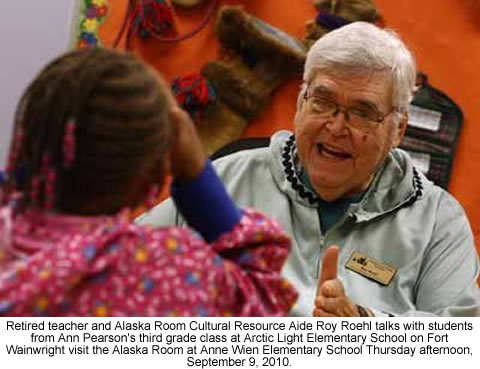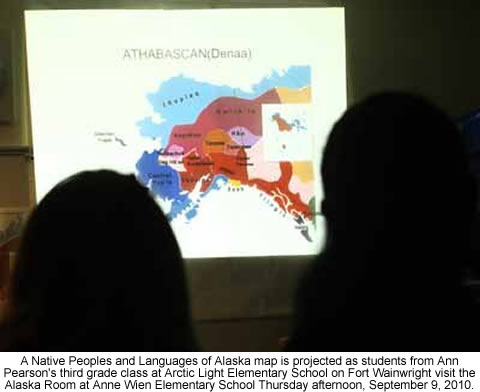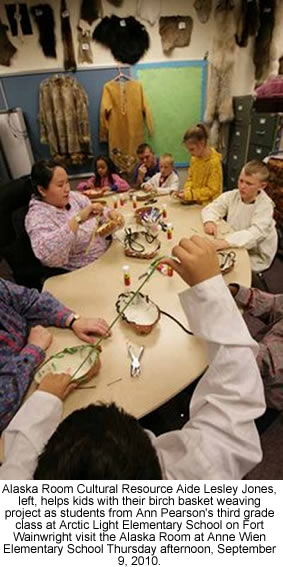 |
Canku Ota
|
 |
|
(Many Paths)
|
||
|
An Online Newsletter
Celebrating Native America
|
||
|
October 1, 2010 - Volume
8 Number 10
|
||
|
|
||
|
Innovative Project
Brings Native Culture Tto Thousands Of Alaska Students
|
||
|
by Mary Beth Smetzer
- The Fairbanks (AK) Daily News - Miner
|
||
|
credits: Photos by Eric
Engman - The (Fairbanks, AK) Daily News - Miner/News-Miner
|
|
Thursday afternoon, Ann Pearson’s third-grade class, arriving from Arctic Light Elementary, did just that. The boys donned white cotton hunting jackets similar to traditional seal gut parkas worn by Native men hunting on the arctic ice. The girls were outfitted with traditional kuspuks (summer dresses) trimmed with ric rac. For the next two hours, the youngsters were immersed in Native culture. There was storytelling, beading, basketmaking, dancing, singing and a wealth of information about the Native people of Alaska from their origins to the present day — Aleut, Athabascan, Inupiaq, Yupik and Southeast Indians. The fast-paced program, led by teacher Lillian DeWilde and assisted by three cultural specialists, is presented twice daily. The class is divided into three sections, and the small groups moved from station to station at the sound of a “magic nomadic bell,” intended to refer to nomadic Athabascan Indians who lived a subsistence lifestyle and moved from seasonal camp to seasonal camp to procure game, fish and furs, DeWilde explained.
Manning the story station was retired teacher and Aleut elder Roy Roehl, who immediately engrosses each group with stories of growing up in the Southwest community of Dillingham. School was different during Roehl’s growing-up years — No hot lunches, no school gym and no school buses. Roehl mushed a dog team to class. “At noon we gave them (dogs) a half of a fish and at the end of the day we gave them a whole one,” he explained. “You mean they didn’t have dog food then?” asked one of the attentive listeners. Roehl also explained a simple method used to catch ptarmigan. “We’d set a gill net between two willows, and the next day we’d have ptarmigans and did not spend a (shotgun) shell,” he said. Ears also perked up at Roehl’s telling of a dramatic encounter with a bear while he was berry picking one fine summer day. When he looked up from his berry pail into the face of a bear, the bear was just as startled as he was. “I ran away in one direction, and he ran away in the other direction,” Roehl said. Before he was done, Roehl talked about the variety of Alaska berries, the five salmon species and their various names.
Each child was given a plastic plate of colorful beads and, a small cutout felt picture frame, needle and thread. “Now take a deep breath,” intoned Julia Kakaruk, “I want you to look and listen.” In a short time, many hands were busily at work. Gavin Browning, 8, selected red, white and blue beads to trim his picture frame. “I chose red, white and blue because that’s American, and I love the Army,” he said. Finishing her beadwork project before the magic nomadic bell rang again, Tishera Owens, 8, smiled. “I thought we were just going to learn stuff,” she said, delighted with the hands-on project. The next stop, overseen by Lesley Jones, featured birchbark basketmaking using paper materials simulating tree bark. Again the students got down to business. They folded, pasted and wholly transformed a paper pattern into an attractive facsimile of a traditional basket, albeit bound with yarn instead of willow roots. Afterward, DeWilde had a few questions for the students. “What is culture?” she asked. “How you live your life.” was the prompt reply from one of the students. “Perfect,” responded DeWilde. Responding to a question about what languages, other than English, were spoken in their homes, student answers included Spanish, Jamaican and Samoan. The children’s only assignment was to ask someone in their own household about their family’s cultural heritage. “It is so important to know your culture,” DeWilde stressed. “You are going to meet thousands of people in school before you are finished. If you don’t know your own culture, you won’t be able to understand other cultures,” she said. And as a final treat, the students were introduced to Eskimo and Indian dances and songs, accompanied by the beat of drums. “Every song is a story,” DeWilde explained. “Athabascans use their voices (singing while dancing), Eskimos use their bodies, she said as she simulated paddling a boat while hunting and looking for ducks. “That’s how we had to learn our history through our dance and through our stories,” DeWilde said. Each school year, thousands of schoolchildren visit the Alaska Room from district schools, homeschools, charter schools and private schools. The Alaska Room is a rich environment, filled to overflowing with information and artifacts representing Natives from all parts of the state. “We try to represent all the cultures,” DeWilde said. Fridays often find DeWilde traveling to elementary, middle and high schools throughout the district, giving presentations and filling special requests on a variety of cultural topics. One of the long-term goals of the Alaska Room program, DeWilde explained, is to eradicate racial tensions by teaching children to value and respect their own and other cultures when they are young. |
|
|
||
|
|
||
| Canku Ota is a free Newsletter celebrating Native America, its traditions and accomplishments . We do not provide subscriber or visitor names to anyone. Some articles presented in Canku Ota may contain copyright material. We have received appropriate permissions for republishing any articles. Material appearing here is distributed without profit or monetary gain to those who have expressed an interest. This is in accordance with Title 17 U.S.C. Section 107. | ||
|
Canku Ota is a copyright ©
2000, 2001, 2002, 2003, 2004, 2005, 2006, 2007, 2008, 2009, 2010
of Vicki Barry and Paul Barry.
|
||
 |
 |
|
|
The "Canku
Ota - A Newsletter Celebrating Native America" web site and
its design is the
|
||
|
Copyright ©
1999, 2000, 2001, 2002, 2003, 2004, 2005,
2006, 2007, 2008, 2009, 2010
of Paul C. Barry.
|
||
|
All Rights Reserved.
|
||
 FAIRBANKS
— The first item of business for students visiting the Alaska
Room at Anne Wien Elementary is getting dressed.
FAIRBANKS
— The first item of business for students visiting the Alaska
Room at Anne Wien Elementary is getting dressed. There
was no time to be bored. After a slide presentation about the history
and diversity of Alaska’s first inhabitants, the groups were
on the go.
There
was no time to be bored. After a slide presentation about the history
and diversity of Alaska’s first inhabitants, the groups were
on the go. At
another station, children sat for a lesson in the basic steps of
decorative beadwork.
At
another station, children sat for a lesson in the basic steps of
decorative beadwork.